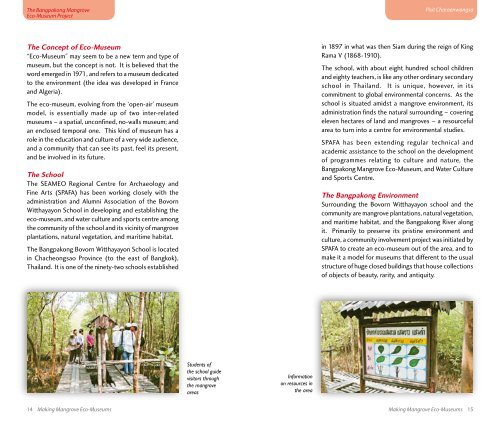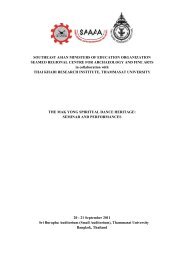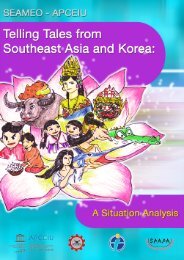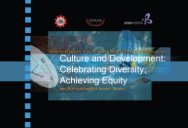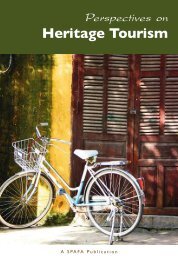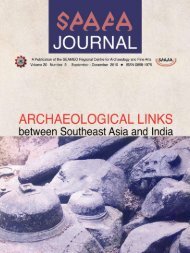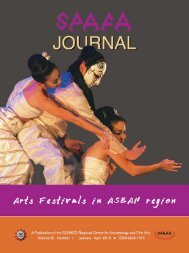Making Mangrove - Seameo-SPAFA
Making Mangrove - Seameo-SPAFA
Making Mangrove - Seameo-SPAFA
You also want an ePaper? Increase the reach of your titles
YUMPU automatically turns print PDFs into web optimized ePapers that Google loves.
The Bangpakong <strong>Mangrove</strong>Eco-Museum ProjectPisit CharoenwongsaThe Concept of Eco-Museum“Eco-Museum” may seem to be a new term and type ofmuseum, but the concept is not. It is believed that theword emerged in 1971, and refers to a museum dedicatedto the environment (the idea was developed in Franceand Algeria).The eco-museum, evolving from the ‘open-air’ museummodel, is essentially made up of two inter-relatedmuseums – a spatial, unconfined, no-walls museum; andan enclosed temporal one. This kind of museum has arole in the education and culture of a very wide audience,and a community that can see its past, feel its present,and be involved in its future.The SchoolThe SEAMEO Regional Centre for Archaeology andFine Arts (<strong>SPAFA</strong>) has been working closely with theadministration and Alumni Association of the BovornWitthayayon School in developing and establishing theeco-museum, and water culture and sports centre amongthe community of the school and its vicinity of mangroveplantations, natural vegetation, and maritime habitat.The Bangpakong Bovorn Witthayayon School is locatedin Chacheongsao Province (to the east of Bangkok),Thailand. It is one of the ninety-two schools establishedin 1897 in what was then Siam during the reign of KingRama V (1868-1910).The school, with about eight hundred school childrenand eighty teachers, is like any other ordinary secondaryschool in Thailand. It is unique, however, in itscommitment to global environmental concerns. As theschool is situated amidst a mangrove environment, itsadministration finds the natural surrounding – coveringeleven hectares of land and mangroves – a resourcefularea to turn into a centre for environmental studies.<strong>SPAFA</strong> has been extending regular technical andacademic assistance to the school on the developmentof programmes relating to culture and nature, theBangpakong <strong>Mangrove</strong> Eco-Museum, and Water Cultureand Sports Centre.The Bangpakong EnvironmentSurrounding the Bovorn Witthayayon school and thecommunity are mangrove plantations, natural vegetation,and maritime habitat, and the Bangpakong River alongit. Primarily to preserve its pristine environment andculture, a community involvement project was initiated by<strong>SPAFA</strong> to create an eco-museum out of the area, and tomake it a model for museums that different to the usualstructure of huge closed buildings that house collectionsof objects of beauty, rarity, and antiquity.Students ofthe school guidevisitors throughthe mangroveareasInformationon resources inthe area14 <strong>Making</strong> <strong>Mangrove</strong> Eco-Museums<strong>Making</strong> <strong>Mangrove</strong> Eco-Museums 15


